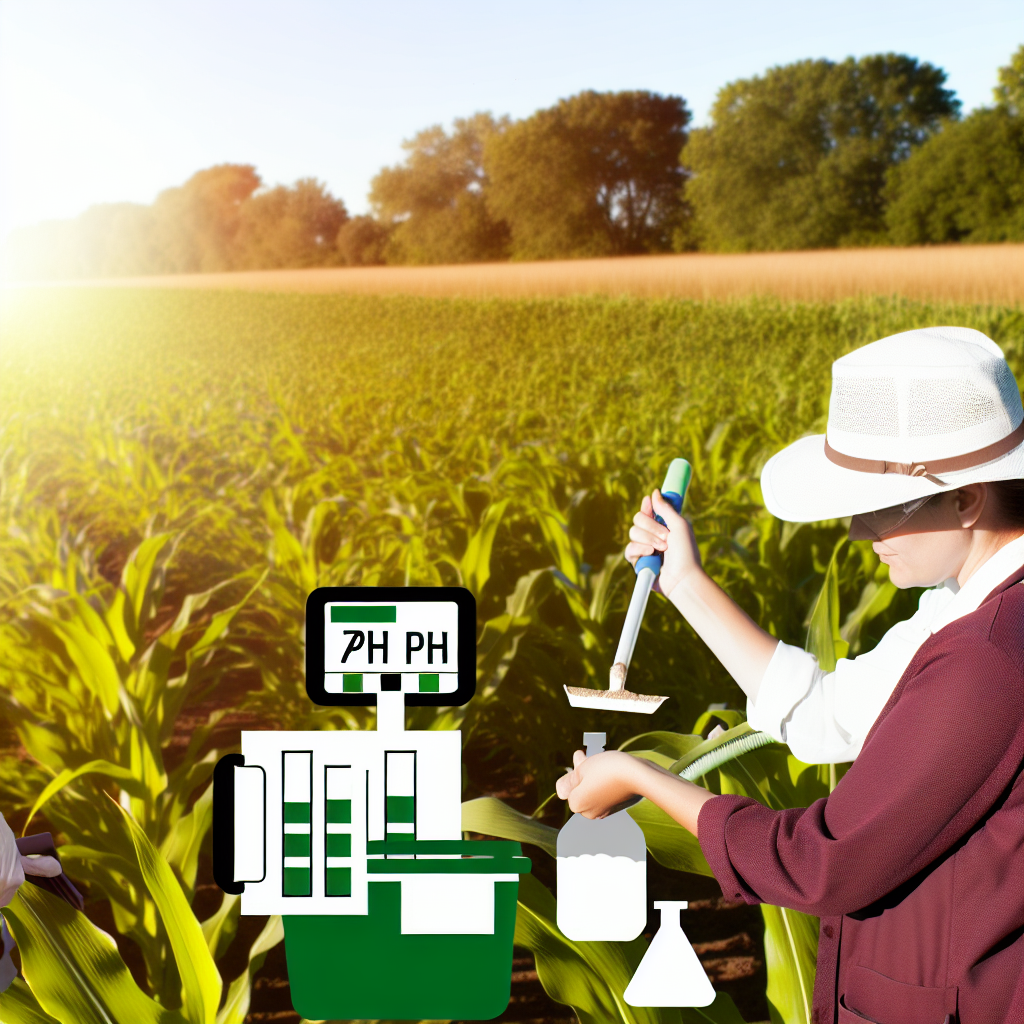Understanding Soil pH: Definition and Importance
Definition of Soil pH
Soil pH measures the acidity or alkalinity of soil.
It represents the concentration of hydrogen ions present.
The pH scale ranges from 0 to 14.
A pH of 7 is considered neutral.
Values below 7 indicate acidity, while values above indicate alkalinity.
Importance of Soil pH in Agriculture
Soil pH significantly affects crop growth.
It influences nutrient availability to plants.
For instance, certain nutrients become less accessible in highly acidic or alkaline soils.
This may lead to nutrient deficiencies in crops.
Optimal pH Range for Common Crops
Different crops thrive within specific pH ranges.
Most crops prefer a pH between 6.0 and 7.5.
For example, corn grows best in moderately acidic to neutral soil.
On the other hand, blueberries prefer more acidic conditions, around 4.5 to 5.5.
Impact of pH on Soil Microorganisms
Soil pH also affects microbial activity.
Microbes play a critical role in nutrient cycling.
Transform Your Agribusiness
Unlock your farm's potential with expert advice tailored to your needs. Get actionable steps that drive real results.
Get StartedSoils with extreme pH levels may disrupt microbial communities.
This can negatively impact soil health and fertility.
Methods to Measure Soil pH
Farmers can use several methods to measure soil pH.
Laboratory testing provides accurate results.
Using a portable pH meter offers convenience for on-site measurements.
Additionally, pH test strips are available for quick assessments.
Adjusting Soil pH
Farmers may need to adjust soil pH for optimal crop growth.
To raise pH, lime is commonly applied.
Conversely, sulfur can lower pH effectively.
It’s crucial to conduct regular soil testing to monitor pH changes.
How Soil pH Affects Nutrient Availability
Understanding Soil pH
Soil pH measures the acidity or alkalinity of soil.
It significantly impacts nutrient availability for crops.
Additionally, pH influences microbial activity in the soil.
A pH of 6 to 7 is generally optimal for most plants.
Nutrient Availability by pH Levels
Nutrients become more available at specific pH levels.
For instance, nitrogen is more accessible in neutral soils.
Meanwhile, phosphorus availability decreases in acidic conditions.
Potassium remains relatively stable across various pH levels.
Effects of Acidic Soil
Acidic soils can lead to nutrient deficiencies.
Essential nutrients like calcium and magnesium may become limited.
In this case, plants struggle to grow and develop.
Effects of Alkaline Soil
Alkaline soils can also pose challenges for crop growth.
Iron and manganese deficiency commonly occurs in high pH soil.
Symptoms include chlorosis, which indicates nutrient deficiencies.
Showcase Your Farming Business
Publish your professional farming services profile on our blog for a one-time fee of $200 and reach a dedicated audience of farmers and agribusiness owners.
Publish Your ProfileAdjusting Soil pH
Farmers can adjust soil pH using additives.
Lime is often used to raise pH in acidic soils.
Sulfur can help lower pH in alkaline conditions.
Regular soil testing helps monitor pH levels effectively.
Importance of Soil pH Management
Managing soil pH is crucial for optimal crop growth.
Understanding its impact on nutrient availability promotes better farming practices.
Ultimately, a balanced pH results in healthier crops and better yields.
Methods for Measuring Soil pH
Importance of Soil pH Measurement
Measuring soil pH is crucial for optimal crop growth.
A proper pH level ensures nutrient availability for plants.
It also helps in managing soil health effectively.
Using pH Test Kits
pH test kits provide a simple way to measure soil acidity.
They typically include a color chart for easy interpretation.
To begin, collect soil samples from various locations.
Next, mix the samples with distilled water as directed.
Finally, compare the resulting color with the chart.
Digital pH Meters
Digital pH meters offer quick and accurate pH readings.
They require calibration before use for precise results.
First, prepare the soil by mixing it with distilled water.
Then, insert the probe into the soil mixture.
Read the display for an immediate pH value.
Laboratory Analysis
Laboratory analysis delivers highly reliable pH results.
Collect samples and send them to a certified lab.
Labs use more sophisticated equipment for accuracy.
They also provide detailed reports on soil health.
Signs of Unbalanced Soil pH
Identifying signs of unbalanced pH can help with management.
- Poor plant growth and yellowing leaves often indicate issues.
- Weeds may thrive in specific pH conditions.
- Low yields can signal a need for pH adjustment.
Regular Monitoring
Regular monitoring of soil pH supports overall farm health.
Consider testing pH at the beginning of each growing season.
This practice helps anticipate and adjust for crop needs.
Additionally, it allows farmers to learn how soil changes over time.
Find Out More: Using Satellite Imagery For Precision Farming
Common Causes of Soil pH Imbalance
Natural Factors
Soil pH can fluctuate naturally due to various environmental factors.
Rainfall influences soil acidity by leaching minerals from the soil.
Heavy rain can lead to more acidic soils, particularly in humid climates.
On the other hand, dry conditions may result in higher pH levels.
Additionally, soil parent material impacts pH levels across regions.
Human Activities
Agricultural practices greatly affect soil pH.
Excessive use of nitrogen fertilizers can lower soil pH.
Crop rotation methods also play a significant role in pH adjustment.
For instance, certain legumes can enhance soil acidity over time.
Moreover, the application of lime helps neutralize acidic soils.
Showcase Your Farming Business
Publish your professional farming services profile on our blog for a one-time fee of $200 and reach a dedicated audience of farmers and agribusiness owners.
Publish Your ProfileRegular testing is essential to monitor these changes effectively.
Soil Organisms
Microbial activity in the soil can cause pH fluctuations.
Decomposing organic matter releases acids, affecting pH levels.
Some fungi and bacteria thrive in acidic conditions, altering the environment.
This biological activity highlights the importance of soil health management.
External Inputs
Pesticides and herbicides may also influence soil acidity.
Some chemical applications can lead to long-term pH changes.
It is crucial to select products carefully to minimize pH disruption.
Understanding the impact of these substances aids in sustainable farming.
Soil Management Practices
Improper tillage practices can affect soil structure and pH balance.
Deep plowing can disturb layers and introduce acidity to topsoil.
Conversely, no-till methods help maintain a stable pH over time.
Water management practices play a role in maintaining optimal pH levels.
Proper irrigation can prevent the buildup of salts that alter pH.
See Related Content: Machine Learning Applications In Crop Management
Strategies for Adjusting Soil pH
Using Lime to Raise Soil pH
Lime is a common amendment for raising soil pH levels.
Farmers apply lime to counteract soil acidity.
This process improves nutrient availability in the soil.
Common types of lime include limestone and dolomitic lime.
Dolomitic lime also adds magnesium to the soil.
Before applying lime, test the soil pH to determine needs.
Generally, use about 1 to 2 tons of lime per acre.
Additionally, incorporate lime into the topsoil evenly.
Allow time for lime to react with the soil.
Typically, it may take several months for lime to affect pH.
Impact of Time and Management
Timing is crucial when applying lime.
Consider applying lime in the fall for spring planting.
This allows sufficient time for pH adjustment.
Maintain soil health by monitoring pH levels regularly.
Using Sulfur to Lower Soil pH
Sulfur is an effective solution for reducing soil pH.
It works particularly well in alkaline soils.
When sulfur is applied, soil bacteria convert it to sulfuric acid.
This acidification can enhance nutrient uptake by crops.
Apply sulfur based on soil testing recommendations.
Common forms include elemental sulfur and ammonium sulfate.
Ammonium sulfate also supplies nitrogen to the soil.
Application Techniques for Sulfur
Evenly spread sulfur across the affected area.
Consider incorporating it into the soil to speed up reactions.
Like lime, allow time for the sulfur to take effect.
Regularly reassess soil pH after application.
Showcase Your Farming Business
Publish your professional farming services profile on our blog for a one-time fee of $200 and reach a dedicated audience of farmers and agribusiness owners.
Publish Your ProfileCombining Amendments for Best Results
In some situations, combining both lime and sulfur may be beneficial.
This approach caters to both acidic and alkaline soils.
Adjustments depend on specific crop needs and soil conditions.
Always follow soil test recommendations for accurate application.
Ultimately, proper management leads to optimal crop growth.
Uncover the Details: Best Practices In Crop Health Monitoring Systems

Crop Selection Based on Soil pH Levels
Importance of Soil pH in Crop Growth
Soy pH significantly impacts nutrient availability for crops.
It affects microbial activity in the soil.
Proper pH levels can enhance crop yield effectively.
On the contrary, unsuitable pH can lead to poor growth.
Understanding pH Levels
Soy pH is measured on a scale ranging from 0 to 14.
A pH of 7 represents neutral soil conditions.
Values below 7 indicate acidic soil, while values above indicate alkalinity.
Different crops thrive in varying pH conditions.
Crops for Acidic Soils
Some crops prefer acidic pH levels below 6.0.
Blueberries thrive well in acidic conditions.
Additionally, potatoes and lilies perform best in similar pH ranges.
Farmers can optimize yields by selecting these plants for acidic soils.
Crops for Neutral Soils
Neutral soil pH is optimal for many staple crops.
Wheat and corn grow best in pH levels around 6.0 to 7.0.
These crops benefit from balanced nutrient availability.
Therefore, maintaining neutral pH supports their growth.
Crops for Alkaline Soils
Specific crops thrive in alkaline conditions above pH 7.0.
Chickpeas and alfalfa are excellent choices for alkaline soils.
These plants adapt well to high pH levels.
Thus, selecting them can improve farming efficiency in alkaline areas.
Testing Your Soil pH
Regular soil testing provides accurate pH measurements.
Farmers should test their soil before planting crops.
Using home testing kits can be an easy way to check pH.
Professional lab testing offers more detailed insights.
Adjusting Soil pH
Farmers can alter pH using soil amendments.
Adding sulfur can lower pH for acidic crops.
Conversely, lime can raise pH levels for alkaline crops.
Proper adjustments lead to improved crop health and yield.
Explore Further: Managing Pests and Diseases with Cover Crops
Monitoring Soil pH: Best Practices and Frequency
Understanding Soil pH
Soyl pH significantly influences nutrient availability.
It dictates microbial activity and plant health.
Maintaining optimal pH ensures vibrant crop growth.
When to Test Soil pH
Regular testing is crucial for effective soil management.
Consider testing before planting each season.
Showcase Your Farming Business
Publish your professional farming services profile on our blog for a one-time fee of $200 and reach a dedicated audience of farmers and agribusiness owners.
Publish Your ProfileAnnual testing helps maintain optimal pH levels.
Additionally, test after applying fertilizers.
Consider testing during periods of heavy rainfall.
How to Collect Soil Samples
Proper sampling ensures accurate results.
Begin by clearing any surface debris from the area.
Use a clean tool to collect soil from multiple spots.
Combine samples for a representative analysis.
Avoid areas with chemical spills or obvious pollution.
Testing Methods
There are several ways to test soil pH effectively.
Home test kits are affordable and user-friendly.
Laboratory tests provide detailed insights but may cost more.
Consider using electronic pH meters for quick results.
Interpreting Soil pH Results
Understanding your results is essential for crop success.
A pH of 6.0 to 7.0 is generally ideal for most crops.
Soils below pH 6.0 are considered acidic.
Soils above pH 7.0 are alkaline and may need adjustment.
Adjusting Soil pH
When necessary, you can adjust soil pH easily.
Use lime to raise pH in acidic soils.
Sulfur can lower pH in alkaline soils effectively.
Always follow product guidelines for application rates.
Best Practices for Regular Monitoring
Create a soil testing schedule for consistency.
Record pH changes along with crop yields.
Regularly observe plant health and growth trends.
Adjust practices based on your monitoring results.
The Role of Organic Matter in Soil pH Management
Understanding Organic Matter
Organic matter consists of decomposed plant and animal material.
It enriches the soil, improving its structure and nutrient content.
This material also plays a crucial role in soil pH balance.
Impact on Soil pH
Organic matter buffers soil pH, preventing drastic fluctuations.
It acts as a reservoir for nutrients, releasing them slowly.
This gradual release helps maintain a stable pH level in the soil.
Enhancing Microbial Activity
Higher organic matter content promotes microbial activity in soil.
Microorganisms contribute to the decomposition of organic materials.
As they break down organic materials, they produce organic acids.
These acids can lower pH, making the soil more acidic.
Strategies for Adding Organic Matter
Farmers can use cover crops to enhance organic matter levels.
Composting also provides a valuable source of organic material.
Regularly adding manure can further enrich the soil.
It is essential to diversify organic matter sources for better results.
Monitoring pH Levels
Farmers should regularly test soil pH to assess changes.
Understanding pH trends helps in making informed decisions.
Showcase Your Farming Business
Publish your professional farming services profile on our blog for a one-time fee of $200 and reach a dedicated audience of farmers and agribusiness owners.
Publish Your ProfileAdjusting organic matter inputs can optimize soil conditions.
This proactive approach supports sustainable crop production.




